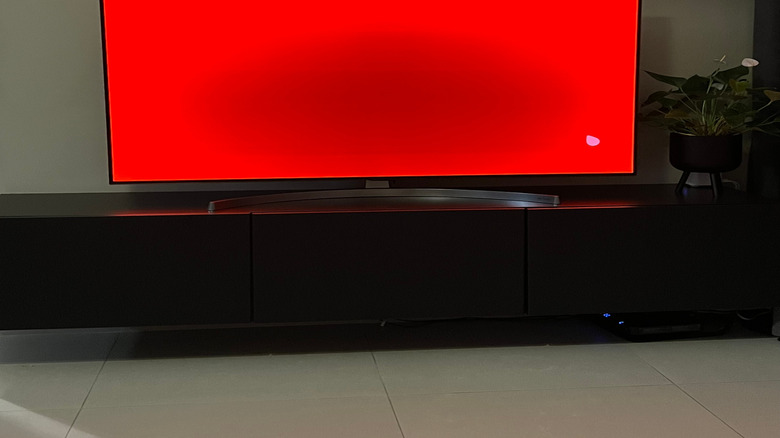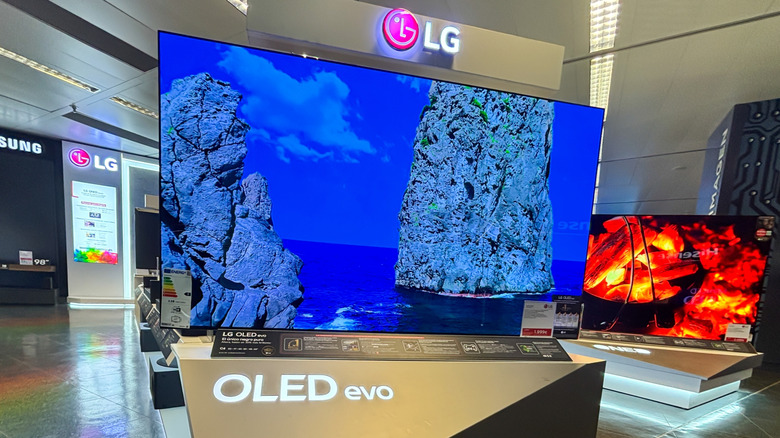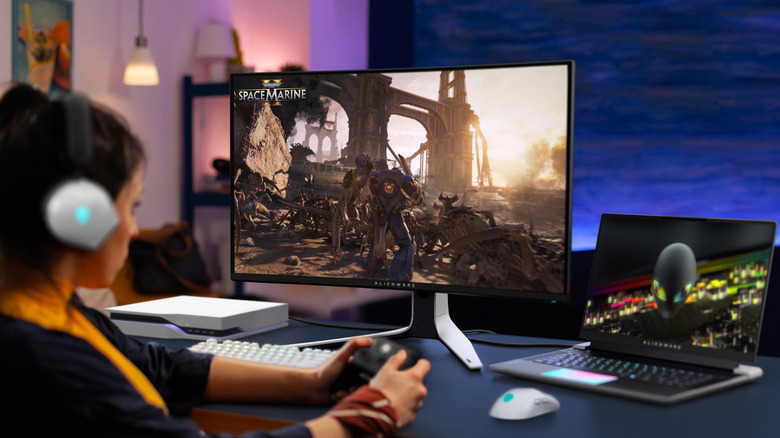Should You Be Worried About Burn-In On OLED TVs And Monitors?
As far as display panels go, OLEDs are the best choice for everything from phones and tablets to monitors and TVs. They offer superior color output, better viewing angles, higher brightness, and, more importantly, deeper blacks that help achieve fantastic contrast. But for all their visual perks, they also come with a functional caveat known as OLED burn-in, or simply as screen burn-in.
In the simplest terms, it refers to permanent discoloration of a pixel cluster, which leads to a ghost artifact that's always visible on the screen. This happens when the same image, or UI element, has been visible on the screen for a long time in the same spot for an extended amount of time. Think of it as a visual remnant or prolonged image retention, though there are steps you can take to prevent burn-in. Usually, the burn-in happens in areas where you see static elements, such as navigation buttons at the bottom of the screen, iconography in the corner, brand tickers, or menu icons on the edge of the panel.
Burn-in is permanent, as it arises from a permanent color imprint on the underlying pixels. It's not an issue that is inevitable for every OLED panel out there. It mostly arises under very specific viewing conditions, especially where static UI elements are left visible at high brightness levels for a prolonged interval. With some behavioral change, recent upgrades to the underlying technology, and a few software-level features can go a long way at avoiding OLED burn-in.
Cause and inevitability
According to a paper published in the Journal of the Society for Information Display, burn-in happens due to the decay-prone nature of the organic semiconductor material used on OLED screens. Unlike LCD panels, each pixel is independently illuminated on an OLED screen. In particular, the disparity in energy required to sustain the blue pixel creates issues that eventually lead to discoloration or after-image issues. The paper notes that burn-in accelerates if the same images are seen at high brightness levels for a long period of time.
That doesn't always replicate in real-world utility. "It is rare for an average TV consumer to create an environment that could result in burn-in," says LG, adding that it will only happen if the static on-screen elements are visible, typically at the highest brightness levels for hours or days, on end. "It is possible to create image retention in almost any display if one really tries hard enough. And even if image retention does occur from extreme usage, it can usually be mitigated within a short period of time," says the company.
So, unless you have extremely poor screen hygiene or get a bad supply lottery, in which case you should seek a repair or replacement for the defective TV screen, the chances of seeing burn-in damage on a modern OLED TV and monitor are quite low. "I personally think there's more 'concern' than real impact of burn-in, and that's unfortunate, as the lifetime of the materials has been improved over time, and the problem is generally well-handled," Roland Wooster, who heads the Display Performance Metrics Task Group at VESA, told ArsTechnica.
Control and mitigation
The folks over at RTINGS performed a long-term burn-in test covering over a hundred TVs and monitors spanning more than half a million hours of runtime. Over a period of ten months and 6,000 hours of screen-on time, which amounts to more than four years of real-world usage. "As for burn-in, well, unfortunately, it seems like burn-in is still an issue, but newer panels are clearly better than older generations, and it seems like most people shouldn't worry about it with varied content," the experts concluded.
Over the years, brands have adopted hardware and software-level solutions to avoid instances of burn-in. LG, for example, says the OLED panel on its TVs comes with self-healing properties that automatically fix short-term image retention issues, thereby avoiding permanent pixel discoloration. The company notes that its Screen Saver feature automatically turns on if it detects static imagery on the screen for more than two minutes.
The Clear Panel Noise essentially resets the pixel output on the TV, the Screen Shift feature slightly moves the visual frame, and the Logo Luminance Adjustment makes brightness adjustments around static images to avoid burn-in. Sony provides a similar built-in screen saver feature to avoid OLED pixel issues, alongside dedicated settings for panel refresh, calibration, and pixel shift functions to combat burn-in on its OLED TVs. Sony also suggests that you should turn off the TV — for the whole night from time to time — for improved longevity. Samsung TVs offer a Pixel Refresh function, and so do Corsair and Dell Alienware for OLED monitors.


